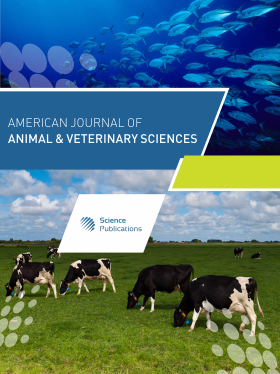Molecular Characterization of Goats Using Random Amplified Polymorphic Dna
- 1 Birsa Agricultural University Jharkhand, India
Abstract
Black Bengal goat is a very valuable goat breed in India. The present investigation was proposed to be undertaken to evaluate gene flow, phylogeographic history, genetic structure and differentiation of both the goat populations to study genetic variation prevailing among Black Bengal and Black Bengal type goat in west Bengal and Jharkhand respectively and to study genetic relationship between both goat populations and to study population structure and gene flow between these two goat populations. This experiment was conducted in the department of animal breeding and genetics (molecular biology laboratory). DNA was extracted from 50 goats from each of the Black Bengal and Black Bengal type goats of Jharkhand and the extracted DNA was observed by gel electrophoresis. Ten specific goat specific primers were obtained from sigma. All the primers except for primers one and two were capable of priming polymorphic amplification pattern in both the breeds. Random Amplification of Polymorphic DNA-Polymerase Chain Reaction (RAPD-PCR) analysis was carried out using DNA samples of 50 Black Bengal goat and 50 Black Bengal type goats of Jharkhand (referred to as Jharkhand black) goat breeds. Only unambiguous, reproducible and scorable polymorphic fragments were taken into consideration for analysis. The amplification pattern of representative samples of Black Bengal showed that primers 6,7,8,9 were highly polymorphic. Polymorphism Information Content (PIC) or expected heterozygosity scores varied from a minimum of 0.219 for primer sigma 06-3 to a maximum of 0.486 for primer sigma 04 with over all mean 0.411 in Black Bengal goat. Similarly for Jharkhand Black, the value of PIC ranged from a minimum of 0. 278 for primer sigma 06-3-0.496 for primer sigma10-2 with over all mean value of 0.413. Data were analyzed by using a computer programe POPGENE (Version 1.31). A more appropriate measure of genetic variation within a population is gene diversity .It was observed that, mean value of Nei,s Gene diversity value (h) was 0.3750 for Black Bengal and was 0.4022 for Jharkhand black. In case of Black Bengal, it was found that the maximum value of Nei’s gene diversity was 0.4861 for locus sigma 6-2 and sigma 9-2 while the minimum value of 0.0664 was found for locus Sigma 04. In Jharkhand Black the maximum value of Nei’s gene diversity (h) was found to be 0.4965 for locus Sigma 10-2 and sigma06-1and the minimum value was 0.2491 for locus sigma 08-1. Dendrogram based on Nei’s genetic distance using Unweighted Pair Group Method of Arithmetic Means (UPGMA) indicated relative closeness and distance of the two goat breed. This study was mainly done on breeds raised in marginal agricultural areas in order to assist in situ conservation. The result was important with respect to puzzle of goat genetic diversity and conservation. Therefore it can be recommended that within breed diversity is actively maintained to enable these extensively unmanaged stocks to adapt to future demands and conditions and there is ample scope for further improvement in its productivity through appropriate breeding strategies.
DOI: https://doi.org/10.3844/ajavsp.2013.45.49

- 6,029 Views
- 5,481 Downloads
- 5 Citations
Download
Keywords
- Black Bengal
- Molecular Characterization
- Genetic Distance
- Situ Conservation
